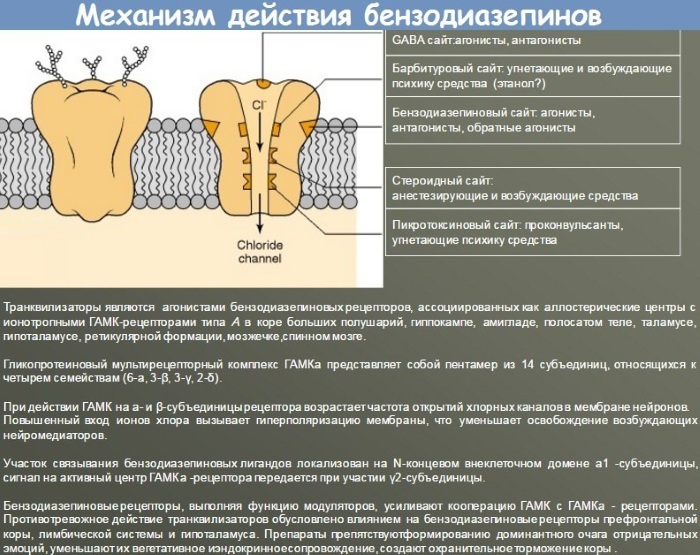Content
- Location, structure and function of the temporomandibular joint
- Causes of TMJ dysfunction
- Symptoms
- Pathogenesis
- Classification and stages of development
- Diagnostics
- Treatment
- Exercises
- Occlusive therapy
- Braces installation
- When is TMJ surgery performed?
- Complications
- Forecast
- Temporomandibular Joint Dysfunction Videos
Temporomandibular joint dysfunction (TMJ) Is a pathology characterized by complete or partial loss of joint function and accompanied by impaired chewing, speech disorders, and pain. The disease has characteristic symptoms and requires compulsory therapy.
Location, structure and function of the temporomandibular joint
The temporomandibular joint is a combination of 2 large joints at once (left and right). This system connects the lower jaw to the base of the skull.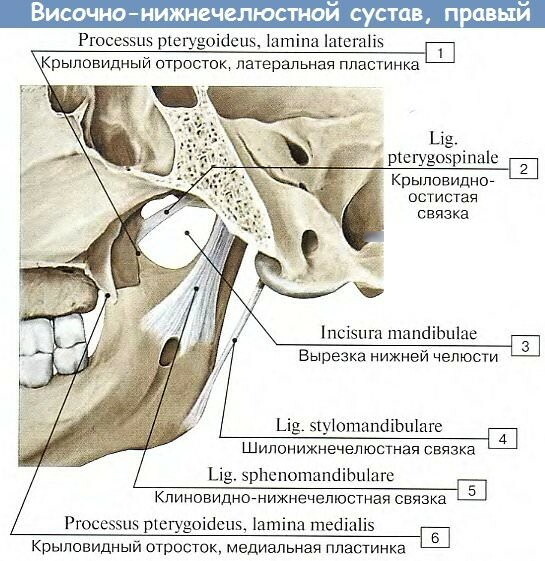
| Joint elements | Description |
| The head of the lower jaw | The element is represented by a bulge and has an oblong ellipso-like shape. In front of the head is the lateral pterygoid muscle. The surface of the element itself is covered with cartilage, which has a fibrous-like structure. |
| The articular surface of the mandibular fossa | The size of the element exceeds the size of the head by 2-3 times. It has the shape of an ellipse and is divided into 2 parts - anterior and posterior (intra- and extracapsular). |
| Articular tubercle of the temporal bone | This element is an anatomical feature unique to humans. It is a miniature eminence emanating from a process located in the cheekbone region. |
| Articular disc | The disc divides the articular cavity into 2 parts. It consists of fibrous cartilage and has the shape of a biconcave lens. The main function of the disc is to distribute a uniform transition between the head of the glenoid fossa. |
| Articular capsule | The element provides the motor ability of the lower jaw. Its upper part is attached to the zygomatic bone, the lower part goes along the neck of the process located in the joint. |
| Articular ligaments | They are subdivided into intracapsular and extracapsular. They differ in structure, function and other distinctive characteristics. |
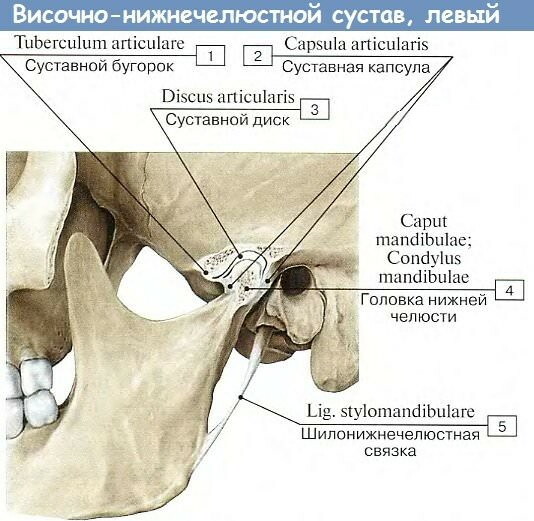 The TMJ is responsible for the normal functioning of the lower jaw in 3 main directions:
The TMJ is responsible for the normal functioning of the lower jaw in 3 main directions:
- Vertical - opens and closes the mouth.
- Horizontal - lateral displacement of the lower jaw relative to the upper jaw.
- Sagittal - displacement of the jaw back and forth in relation to the upper jaw.
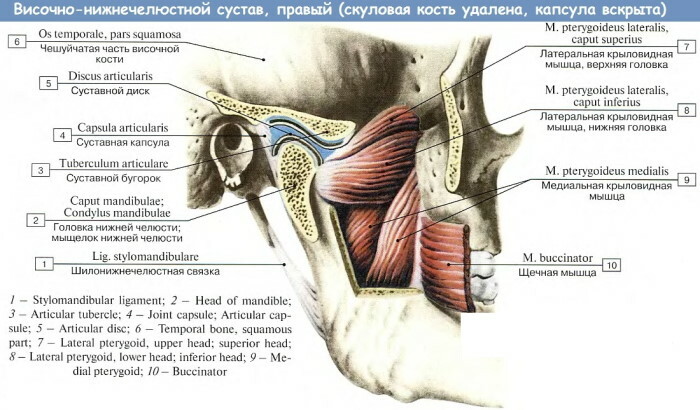 Thanks to the joint, the normal operation and function of other related systems, which are responsible for speech, chewing food, and yawning, are ensured.
Thanks to the joint, the normal operation and function of other related systems, which are responsible for speech, chewing food, and yawning, are ensured.
Causes of TMJ dysfunction
The causes of the disease can be different and are subdivided based on the nature of the origin of the disorder.
Possible reasons:
- defects in the structure of the teeth or dental diseases - malocclusion, jaw injuries, improperly performed prosthetics, abnormal structure of the teeth and jaw;
- disorders in the jaw muscles - spasms, high load on the chewing muscles, chewing food on one side, bruxism, increased load on the speech apparatus;
- physical or mental stress - stress, neuroses, arrhythmias, high blood pressure.
These reasons are predisposing factors and in most cases end with the development of TMJ.
Symptoms
Dysfunction of the temporomandibular joint (symptoms and treatment of the disease may differ depending on the individual characteristics of the human body) can manifest itself in different ways. However, pathology is characterized by some general manifestations that do not depend on the severity and form of the disorder.
The symptoms of the disease are divided into several large groups, on the basis of which the diagnosis is made.
Symptoms:
-
Sound anomalies. In most cases, clicking develops in the area of the joint. This effect occurs when you open your mouth, while chewing food, or when yawning. The volume of the effect can be heard by others. The pain syndrome does not develop in all cases. There may also be a popping, squeaking or crunching sound.

- Joint blockage. Closing the joint causes the patient to find a point or position at which the jaw can be opened.
- Painful sensations. Formed in various points or parts of the masticatory muscles. In this case, pain can also have different localization - in the head, on the face, in the teeth.
- Other symptomatology. Pathology can be accompanied by the development of dizziness, sleep disorders, depression, noise or ringing in the ears. You may also experience problems with swallowing, dry mouth, pain in the tongue, paresthesia, snoring, respiratory arrest during sleep (sleep apnea).
Most patients develop a malocclusion because of the change in the movement of the teeth during the disease.
In the later stages, signs may occur:
- violation of the function of chewing food (with concomitant pain syndrome);
- painful point sensations in the muscles;
- the formation of seals in the area of the masticatory muscles (found when probing problem areas);
- changed position of the lower jaw;
- violations when opening the mouth - jerking, unevenness.
In the absence of timely therapy, the pathology can worsen and lead to various deforming and degenerative changes that cannot be treated.
Pathogenesis
Occlusive disorders are one of the most common causes of the disease. Against the background of such disorders, the pathways in the joints are restructured and the functional load increases. Degeneration of cartilage tissue leads to disruption of the functioning of the articular heads, which causes a change in the surface of the joints.
Clicking is formed as a result of sudden movements of the head of the joint and a decrease in the amount of synovial fluid. At the same time, the surface and structure of the joints changes, which prevents the full movement of the articular elements.
Pain syndrome occurs against the background of compression of the nerve endings and the capsule. In this case, ligaments are also stretched, which causes irritation of the nerve fibers located in the area of \ u200b \ u200bthe vessels.
The psychological factor is due to nervous tension, which is accompanied by night grinding of teeth. The development of bruxism leads to overstrain of the periodontitis area and causes increased muscle tone, which provokes abrasion of the teeth. This causes anatomical abnormalities in the structure of the dentition.
In some cases, the presence of several provoking factors at once is noted, which lead to the development of pathology.
Classification and stages of development
Dysfunction of the temporomandibular joint (symptoms and treatment of the disease at each stage may be different) is divided into several subspecies and types. At the moment, a clear classification of the disease has not been established.
Pathology is conventionally divided according to the nature of origin:
- myogenic;
- atrogenic;
- psychogenic.
In all 3 cases, dysfunction is accompanied by painful sensations of varying intensity.
Also, during the course of the disease, 2 periods are distinguished:
- Dysfunction of the temporomandibular joint.
- Spasms of the masticatory muscles, accompanied by the development of pain syndrome.
In the first case, there are no noticeable changes in the structure of the joint. In this case, only clicks can arise from the symptoms.
In the second stage, noticeable structural changes take place. In more severe cases, perforation or tearing of the articular disc may occur.
Diagnostics
To determine the disease and make a diagnosis, it is necessary to undergo examinations at once by several specialists. In this case, the treatment of pathology is carried out by 2 doctors - a neurologist and a dentist.
First of all, the patient's complaints are heard, a visual examination of the jaw is carried out, the symmetry of the skull is assessed.
When examining the jaw, the following criteria are taken into account:
- type of bite;
- lack of dental units;
- the presence of fillings and prostheses;
- mobility and smooth movement of the jaws;
- painful sensations;
- the presence of swelling.
Auscultation is also prescribed - listening to the sounds that the patient pronounces. The technique is mandatory, since in most cases dysfunction is accompanied by sound disturbances.
Additionally, an occludogram can be performed - a wax exposure, which allows you to determine the degree of closure of the lower and upper jaws.
To establish the force of compression of the masticatory muscles, gnathodynamometry can be performed.
Instrumental types of diagnostics:
- X-ray (jaw and head projection).
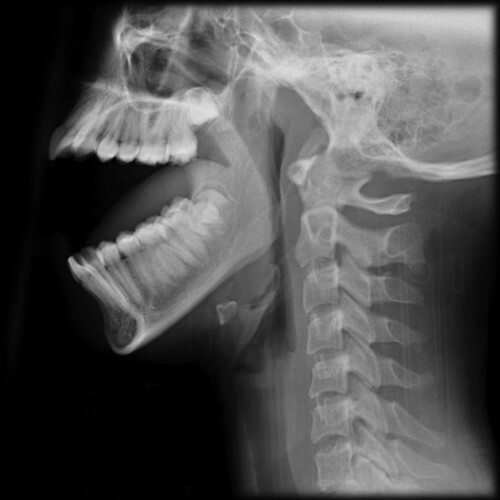
- Tomography - allows you to assess the condition of the bone structure.
- MRI - determination of the displacement of the disc and deforming changes in it.
- Arthrography with a contrast agent - diagnosis is necessary before surgery, and also helps to establish a separation of the disc.
If necessary, other examinations can be carried out by other related and narrow-profile specialists - a rheumatologist, a neurologist. Research from these specialists is necessary in the presence of other concomitant diseases - scoliosis, pinched nerves, dislocations.
Treatment
Dysfunction of the temporomandibular joint (symptoms and treatment of the disease depend on the reasons that provoked its development) requires complex therapy, including corrective exercises and medications.
Treatment is selected based on the severity of the disorder and concomitant symptoms. First of all, medications are prescribed to help eliminate soreness, inflammation and swelling. Pain relievers, non-steroidal anti-inflammatory drugs (NSAIDs) can be used.
Additionally, physiotherapy is carried out. Fluctuorization is the most effective of these procedures. The technique consists in exposing the problem area to low-power electric current discharges and different oscillation frequencies. This method of treatment allows you to quickly eliminate pain syndrome (2-3 sessions are enough).
Phonophoresis with hydrocortisone may also be prescribed. The procedure reduces the intensity of pain and inflammation.
Physiotherapy should be carried out under the control of electromyography, which will assess the effectiveness of the methods used and track their therapeutic effect.
Exercises
Exercise helps to normalize work and relax the chewing muscles.
The most commonly used techniques are:
- Using a marker or felt-tip pen, draw a vertical line on the mirror surface and stand in such a way that this line divides the face exactly in half. Then put your hands on the area of the articular heads on both sides. The patient needs to lift the tongue up and back, open and close the mouth according to the drawn line. If there is a click, it is recommended to open the mouth until it occurs. The exercise should be repeated 2-3 times a day. The number of movements is 30.
- The patient needs to open and close his mouth without closing his teeth. The duration of the exercise is 30 seconds. Then one should alternately touch the left and right cheeks with the tongue for 30 seconds. After that, you must open your mouth again and hold it in this position for 30 seconds. Next, you need to alternately (first in one, then in the other direction) rotate the tongue in front of the teeth. During the exercise, the teeth should be closed. The technique is performed 2-3 times a day for 20 minutes.
Corrective exercises must be performed systematically throughout the main therapy.
Occlusive therapy
Occlusion therapy allows you to fix the position of the lower and upper jaws in the most comfortable position for the patient. For this, a consultation with an orthodontist is carried out, after which a special splint (splint) is made.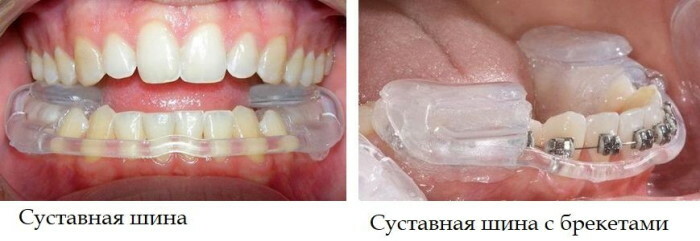
Structures are made of plastic material, which is gradually erased as it is worn. At the same time, they must be worn constantly, even during sleep.
Caring for the tire does not require any special skills and consists of daily cleaning. Remove the structure after eating and rinse under running water using a soft toothbrush.
Braces installation
Dysfunction of the temporomandibular joint (symptoms and treatment of pathology should be monitored by a specialist throughout the entire period of therapy) requires the mandatory installation of special dental designs.
In this case, braces are used as an additional treatment and are installed after occlusive therapy. These structures are necessary to maintain and fix the mandible in the correct position. They can be used in conjunction with tires or separately.
Periodically, a specialist must grind the tire for a more correct combination of both systems.
The wearing of braces is long-term and can take several months. During and after therapy, diagnostic measures are carried out, which allow assessing the effectiveness of the methods used and, if necessary, adjust the position of the splint or bracket system.
When is TMJ surgery performed?
Surgical intervention is prescribed for patients in severe cases, when there are signs of morphological changes in the structure and joint. In most cases, operations are performed when the disc located inside the joint is displaced.
Patients undergo chondroplasty, which allows you to eliminate defects in the cartilage tissue of the joint or the head located in the lower jaw region.
In some cases, the reduction of the offset disc is shown. Suturing of deformed ligaments and joint capsule may also be prescribed. These techniques are the most aggressive and, at the same time, do not always lead to a positive result.
Complications
Dysfunction of the temporomandibular joint (symptoms and treatment of the disorder are always individual, therefore therapy is selected according to the patient's age and other physiological characteristics) requires mandatory observation even after graduation therapy.
Lack of timely treatment can lead to the development of additional difficulties. Thus, the process can turn into a chronic form, when pain syndrome and other symptoms appear unexpectedly with sudden movements of the lower jaw.
In the future, the disease can worsen and lead to dystrophic changes in cartilage and bone tissue, which, in turn, can provoke the development of arthrosis or osteoarthritis. Functional disorders in these cases are not always reversible.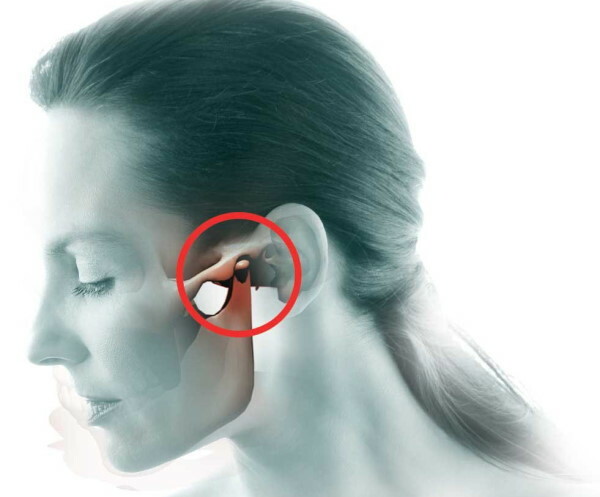
Against the background of stretching of the ligaments and the capsule of the joint, dislocation of the articular head may occur. In this case, reduction of the joint is required, since in case of violation, the motor function of the joint is blocked.
Also, the disease can lead to bruxism, which can cause chronic injury. In most cases, these complications are not reversible.
Forecast
The prognosis for the complete elimination of pathology is favorable at the initial stages of its development, when there are no visible structural changes.
With deformities, detachment or other degenerative changes in the intra-articular disc, the prognosis is not always favorable, because even with the help of surgical intervention, it is not possible to eliminate the problem in all cases.
Prevention:
- Timely treatment of dental diseases or correction of anomalies in the structure of the dentition and jaws.
- Elimination of bad habits - chewing on one side, grinding teeth during psycho-emotional stress, chewing pens or pencils.
- Psychological correction and assistance (in the presence of risks of the psychological nature of the origin of the disorder).
After elimination of the defect, it is necessary to undergo preventive treatment of muscle spasms and adhesions.
Dysfunction of the temporomandibular joint is a common pathology among the population of different ages. Violation requires a mandatory visit to a doctor and adequate therapy. With the development of the first symptoms of the disease, it is necessary to immediately consult a doctor, since the pathology can worsen and lead to irreversible disorders.
Temporomandibular Joint Dysfunction Videos
Temporomandibular joint dysfunction:



